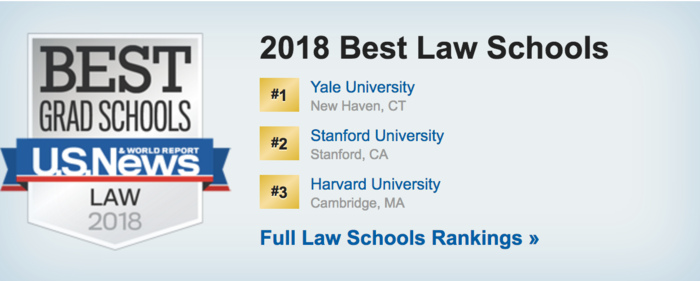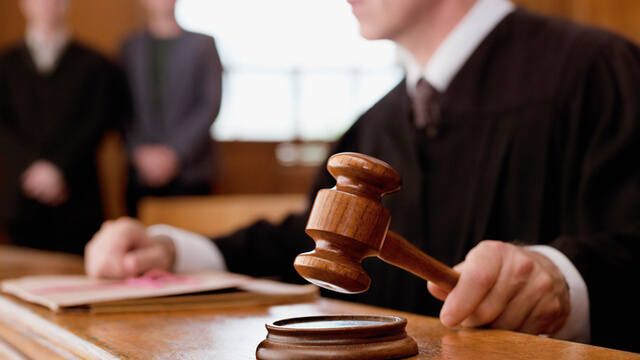Following leaks earlier this month, the official 2018 U.S. News & World Report Law School Rankings were released last week. They present an interesting snapshot of how law schools continue to jockey for position in an uncertain economy and tough legal market, and an opportunity to reflect on just how much "prestige" matters in the legal profession.
This week, we are going to take a harder look at the new rankings. Today's post will focus on the Top 5 and T-14 schools. Stay tuned for additional analysis of schools further down the trough.
The Top 5 Law Schools
1) Yale
2) Stanford
3) Harvard (-1)
4) U Chicago
5) Columbia (-1)
A couple of points worth considering here. This year, there are no "ties" in the Top 5. What you see is what (ranking) you get—and the Ivy Schools formerly tied with non-Ivies have lost out (Harvard Law School lost out to Stanford Law School, and Columbia lost out to Chicago).
Yale Law School and Stanford's relatively tiny class sizes appear to be giving these sterling schools the cutting edge over their elite competition. Harvard and Columbia have each seen a one point drop this year, while the University of Chicago holds steady.
It will be interesting to monitor how, if at all, Harvard and Columbia react. There's already been some speculation that Harvard's drop to #3 is one of the factors motivating the school's recent announcement that Harvard Law will now accept GRE scores instead of LSATs.
The Top 10 Law Schools
6) NYU
7) Penn
8) Michigan
8) UVA
10) Duke (+1)
10) Northwestern (+2)
NYU cannot be happy about remaining outside the Top 5. Here, we do have two ties: Michigan and University of Virginia are co-ranked at #8, and Duke and Northwestern have edged their way into a tie at #10. This is major news, as indicated by the position change markers. If, relative to last year, Duke has improved its rank by one position, and Northwestern by two, that means a major shakeup has taken place in the Top 10 bracket, with potential ripple effects throughout the Top 14 ("T-14"), historically a major dividing marker in law school prestige. Which leads us to:
The T-14 Law Schools
12) Berkeley (-4)
13) Cornell
14) UT Austin (+1)
15) Georgetown (-1)
15) UCLA (+2)
Whoa, whoa, WHOA . . . Boalt drops FOUR positions? What the heck is going on in the Golden State?! Could it be the school's abysmal handling of allegations of sexual harassment by former-dean Sujit Choudhry, or its ongoing budget crisis?
Equally significant: Texas has displaced Georgetown in the T-14, and Georgetown's tie with UCLA has some commentators wondering if it is now more appropriate to speak of a "T-15." I mean, isn't this all super arbitrary anyway? How much real difference can one ranking place make, especially at or near the very top of the law school heap?
There is a strong argument that certain schools—perhaps, very roughly speaking, the top 15 or 20 law schools in the United States—are a cut above the rest because a degree from one of those schools is likely to be considered valuable in any major market, and thus gives a graduate of one of those schools a better chance at a desirable legal job.
Yet, just the THOUGHT of equating the 14th spot with the 15th spot has pissed off other commentators, who insist (perhaps out of self-interest) that the T-14 is not an arbitrary line in the sand but a really meaningful "point of no return" for top ranking purposes. Above the Law reports that one commentator has defined the T-14 as the only law schools that have, at one point or another, been in the Top 10 in the United States. Of course, that commentator is . . . a former dean of admissions at a T-14 school, who just *might* have a vested interest in maintaining the Tyranny of T-14.
Yep, things are a bit . . . strange.
For better or worse, the law remains an extremely hierarchical profession—one in which the quality of the school one attends is likely to have long-lasting consequences for the trajectory of one's entire career. Law school candidates who are able to secure admission to one or more of the top 14 (or 15) schools have much to celebrate: they have cleared one major hurdle standing between them and a successful legal career. Of course, many students graduate from top law schools and flail on the legal job market, but that's a discussion for another day.
vIn our next post, we'll look below the T-14/T-15 line, and assess factors law school candidates would be well-advised to consider *other than* the U.S. News and World Report rankings in trying to navigate a path to success as a legal professional. Stay tuned . . .In the meantime, the Law School 100 has also released its 2018 Law School Rankings and Harvard remains at the top as the #1-ranked law school.












